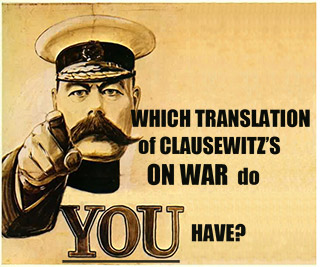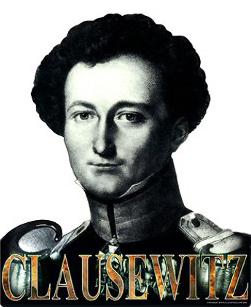

Carl von Clausewitz
NOTE: This version of Carl von Clausewitz's famous treatise On War is a complete version (i.e., it contains all eight books—most on-line versions have only the first four) posting of Colonel J.J. Graham's translation published by Nicholas Trübner in London in 1873. It is derived from the German original, Clausewitz's Vom Kriege (Berlin: Dümmlers Verlag, 3 vols., 1832–34). The 1976/84 Howard/Paret translation from Princeton University Press is the standard English translation today; for the most accurate text one should always consult the Otto Jolles translation, originally done in 1943 at the University of Chicago. For more information on the original German text and on all of the available English translations, click HERE. Please take a look at the relevant books shown below. For a general discussion of the various versions of Vom Kriege/On War available, see ClausewitzStudies.org, "Which Translation of Clausewitz's On War do you have?" For an advanced and rather complex discussion of some important problems with all of the English translations (including Graham's, H/P's (especially), and Jolles'), see Christopher Bassford, "Clausewitz's Categories of War and the Supersession of 'Absolute War.'"
In his 1-volume edition of On War, Graham also translated the two appendices to Vom Kriege:
Die wichtigsten Grundsätze des Kriegführens zur Ergänzung meines Unterrichts bei Sr. Königlichen Hoheit dem Kronprinzen (" The most important principles of warfare to complement my lessons for His Royal Highness the Crown Prince"), usually called "Principles of War" in English, and "Skizze eines Plans zur Taktik oder Gefechtslehre," "Sketch of a plan for tactics or combat theory, variously called, in English, "Sketch of a Plan For Tactics," "Guide to Tactics," or "Theory of the Combat."
Click here for Graham's "Principles of War." We also have Hans Gatzke's 1943 translation.
Another on-line version of Graham's "Principle" can be found at "The On-Line Library of Liberty." This is a scan taken from a 1918 edition on On War, edited (with some very misleading—or at least seriously anachronistic—editorial additions) by COL Frederick Natusch Maude.
Graham's version of Sketch of a Plan For Tactics can also be found in the "The On-Line Library of Liberty" posting of On War. However, a new and far superior translation can be found on-line in Olivia A. Gard's An Annotated Guide to Tactics: Carl von Clausewitz’s Theory of the Combat (Quantico, VA: Marine Corps University Press, 2021). See also her Review of the Graham translation in The Strategy Bridge, 23 MAR 2020.
 Carl von Clausewitz and Arthur Wellesley, First Duke of Wellington, On Waterloo: Clausewitz, Wellington, and the Campaign of 1815. Ed./trans. Christopher Bassford, Daniel Moran, and Gregory W. Pedlow (ClausewitzStudies.org, 2010). ISBN: 1453701508. This book is built around a new and complete translation of Clausewitz's study of the Waterloo campaign (Berlin: 1835), which is a strategic analysis of the entire campaign (not just the Battle of Waterloo), and the Duke of Wellington's detailed 1842 response to it. Clausewitz's Der Felzug von 1815 was written late in his life and its findings were never incorporated into On War, so most readers will find it new material.
Carl von Clausewitz and Arthur Wellesley, First Duke of Wellington, On Waterloo: Clausewitz, Wellington, and the Campaign of 1815. Ed./trans. Christopher Bassford, Daniel Moran, and Gregory W. Pedlow (ClausewitzStudies.org, 2010). ISBN: 1453701508. This book is built around a new and complete translation of Clausewitz's study of the Waterloo campaign (Berlin: 1835), which is a strategic analysis of the entire campaign (not just the Battle of Waterloo), and the Duke of Wellington's detailed 1842 response to it. Clausewitz's Der Felzug von 1815 was written late in his life and its findings were never incorporated into On War, so most readers will find it new material.
 Buy the best translation—recommended for serious readers. The Book of War (The Modern Library, February 2000). ISBN: 0375754776. Clausewitz's On War and Sun Tzu's Art of War in one volume. The translation of Clausewitz's On War is the 1943 version done by German literary scholar O.J. Matthijs Jolles at the University of Chicago during World War II—not today's standard translation, but certainly the most accurate. Sun Tzu is presented in the modern translation by Roger Ames, based on complete ancient texts found by archaeologists.
Buy the best translation—recommended for serious readers. The Book of War (The Modern Library, February 2000). ISBN: 0375754776. Clausewitz's On War and Sun Tzu's Art of War in one volume. The translation of Clausewitz's On War is the 1943 version done by German literary scholar O.J. Matthijs Jolles at the University of Chicago during World War II—not today's standard translation, but certainly the most accurate. Sun Tzu is presented in the modern translation by Roger Ames, based on complete ancient texts found by archaeologists.
 Buy the standard English translation of Clausewitz's On War, by Michael Howard and Peter Paret (Princeton University Press, 1976/84). ISBN: 0691018545 (paperback). Kindle edition. This quite readable translation appeared at the close of the Vietnam War and—principally for marketing and copyright reasons—has become the modern standard.
Buy the standard English translation of Clausewitz's On War, by Michael Howard and Peter Paret (Princeton University Press, 1976/84). ISBN: 0691018545 (paperback). Kindle edition. This quite readable translation appeared at the close of the Vietnam War and—principally for marketing and copyright reasons—has become the modern standard.
 Decoding Clausewitz: A New
Approach to On War (University
Press of Kansas, 2008). By Jon
Tetsuro Sumida. ISBN: 9780700616169. *This is perhaps the most important recent book for anyone seeking to understand Clausewitz's thinking. Sumida contends that
Clausewitz's central value lies in his method of reenacting the psychological
difficulties of high command in order to promote the powers
of intuition that he believed were essential to effective strategic
decision-making. Sumida also correctly notes Clausewitz's argument that the defense is a stronger
form of war, and goes on to explore the implications of that fact.
Decoding Clausewitz: A New
Approach to On War (University
Press of Kansas, 2008). By Jon
Tetsuro Sumida. ISBN: 9780700616169. *This is perhaps the most important recent book for anyone seeking to understand Clausewitz's thinking. Sumida contends that
Clausewitz's central value lies in his method of reenacting the psychological
difficulties of high command in order to promote the powers
of intuition that he believed were essential to effective strategic
decision-making. Sumida also correctly notes Clausewitz's argument that the defense is a stronger
form of war, and goes on to explore the implications of that fact.
On War
by
General Carl von Clausewitz
trans. COL James John Graham
(London: N. Trübner, 1873)
TABLE OF CONTENTS
INTRODUCTORY MATERIAL
• "Clausewitz
and His Works." (This is a contemporary introduction by Christopher Bassford
(originally written 1991, the latest version updated 2023)
• Preface to the First Edition by Marie von Clausewitz
• Notice
• The Introduction of the Author
• 1908 Introduction by Colonel Frederick N. Maude
• Information on the 1873 Translator, Colonel J.J. Graham
plus Christopher Mewett, "J.J. Graham: A Biographical Sketch."
• Some Notes on This Translation
BOOK I: ON THE NATURE OF WAR
• 5. On Bodily Exertion in War
BOOK II: ON THE THEORY OF WAR
• 1. Branches of the Art of War
BOOK III: OF STRATEGY IN GENERAL
• 5. Military Virtue of an Army
• 11. Assembly of Forces in Space
• 12. Assembly of Forces in Time
• 16. On the Suspension of the Act in War
• 17. On the Character of Modern War
BOOK IV: THE COMBAT
• 2. Character of a Modern Battle
• 4. The Combat in General (continuation)
• 5. On the Signification of the Combat
• 8. Mutual Understanding as to a Battle
• 12. Strategic Means of Utilising Victory
• 13. Retreat After a Lost Battle
BOOK V: MILITARY FORCES
• 2. Theatre of War, Army, Campaign
• 4. Relation of the Three Arms
• 5. Order of Battle of an Army
• 6. General Disposition of an Army
• 7. Advanced Guard and Out-Posts
• 8. Mode of Action of Advanced Corps
• 9. Camps
BOOK VI: DEFENCE
• 2. The Relations of the Offensive and Defensive to Each Other in Tactics
• 3. The Relations of the Offensive and Defensive to Each Other in Strategy
• 4. Convergence of Attack and Divergence of Defence
• 5. Character of Strategic Defensive
• 6. Extent of the Means of Defence
• 7. Mutual Action and Reaction of Attack and Defence
• 11. Fortresses (continuation)
• 13. Strong Positions and Entrenched Camps
• 16. Defence of Mountains (continued)
• 17. Defence of Mountains (continued)
• 18. Defence of Streams and Rivers
• 19. Defence of Streams and Rivers (continued)
• 24. Operating Against a Flank
• 25. Retreat into the Interior of the Country
• 27. Defence of a Theatre of War
• 28. Defence of a Theatre of War (continued)
• 29. Defence of a Theatre of War (continued)—Successive Resistance
• 30. Defence of a Theatre of War (continued) When No Decision is Sought For
SKETCHES FOR BOOK VII: THE ATTACK
• 1. The Attack in Relation to the Defence
• 2. Nature of the Strategical Attack
• 3. On the Objects of Strategical Attack
• 4. Decreasing Force of the Attack
• 5. Culminating Point of the Attack
• 6. Destruction of the Enemy’s Armies
• 9. Attack on Defensive Positions
• 10. Attack on an Entrenched Camp
• 11. Attack on a Mountain Range
• 14. Attack on Morasses, Inundations, Woods
• 15. Attack on a Theatre of War with the View to a Decision
• 16. Attack on a Theatre of War without the View to a Great Decision
• 19. Attack on the Enemy's Army in its Cantonments
• 22. On the Culminating Point of Victory
SKETCHES FOR BOOK VIII: PLAN OF WAR
• 3.A. Interdependence of the Parts in a War
• 3.B. On the Magnitude of the Object of the War and the Efforts to be Made
• 4. Ends in War More Precisely Defined—Overthrow of the Enemy
• 5. Ends in War More Precisely Defined (continuation)—Limited Object
• 6.A. Influence of the Political Object on the Military Object
• 6.B. War as an Instrument of Policy
• 7. Limited Object—Offensive War
• 9. Plan of War When the Destruction of the Enemy is the Object
END MATTER
• Index to the 1873 Edition of Graham's Translation of On War
Return to the top of this page
Visit ClausewitzStudies.org
 Visit the
Visit the
Clausewitz Bookstores!
US • UK • France • Germany


